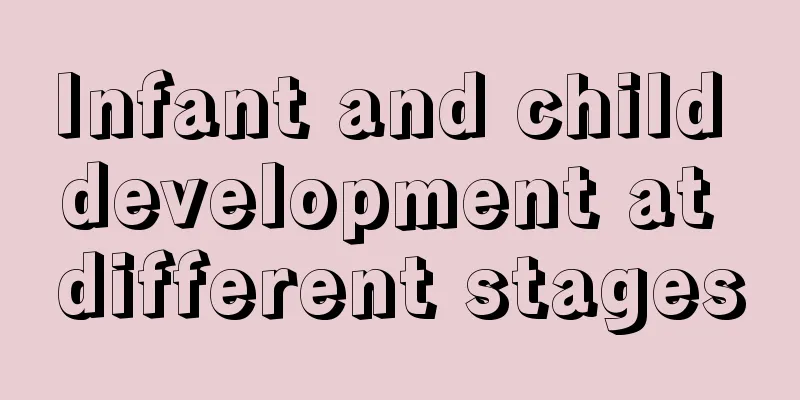Infant and child development at different stages

|
The physical development of infants and young children at different ages has their own characteristics, and it is normal to have differences in the early and late development. However, we must also rule out phenomena such as developmental delay. Some children may even have characteristics of intellectual disability. In order to ensure that there are no physical abnormalities in the child, parents must have a full understanding of the performance of infants and young children at each stage of development. So, what are the manifestations of each stage of infant development? Let’s take a look below.
Seize the three important opportunities for your baby's limb development: Opportunity 1: 0-2 years old. The basic period of children's physical and motor intelligence development is mainly to establish basic abilities in various fields and systems, and to develop basic emotions and daily life functions. Key development areas include the anterolateral tactile system for perception and the large anti-gravity muscle groups for movement. Opportunity 2: 2-4 years old. The turning point in the development of children's physical and motor intelligence is mainly the maturity of the basic functions of various fields and systems, and the beginning of the development of more complex functions and basic independent abilities. Key developmental areas include the posteromedial tactile system for perception and gross motor function for movement. Opportunity three: 4-7 years old. The integration period of children's physical-motor intelligence development focuses on the integration between various functional areas, so as to develop high-skill and high-complexity integrated high-level functions, and at the same time develop a considerable degree of social function. The key development projects include: the vestibular system in perception, the development of fine motor function in movement, the sensory integration function in integration, and the basic thinking function in cognition. Language development indicators There are four stages in the development of a baby's language ability: Stage 1 is 0-1 years old: it is the stage of babbling and language vocabulary accumulation. This vocal practice reaches its peak when the child is 8 months old, and the volume and tone of the words will change to imitate real language, such as: BABA'MAMA... Stage 2 is 1-2 years old: The language characteristics of this period are speaking single-word sentences, and being able to use gestures and expressions to assist language to express needs. He can imitate the bleating of a lamb and likes to ask: "What is this called? What is that?" Stage three is 2-3 years old: children gradually change from being able to speak short sentences to being able to use complex sentences and like to ask questions. How to help your baby: At this time, you should provide your child with a language environment for communication and encourage your child to express himself or herself in long sentences. When he wants cookies, you can slow down and ask him: "Do you want cookies?" The baby will also imitate mom and dad and gradually use complete sentences. Stage 4 is for 3-6 years old: They can speak fluently, use a wide range of word classes, discover grammatical relationships from adults' conversations, correct their own temporary grammatical errors, and gradually form real language. Visual development indicators Exercise methods for the four major stages of baby visual development: 0-6 months - "black and white period": newborn babies can only see light and shadow. They can just see their mother's face when they are breastfeeding, but cannot see anything further away. 6-12 months - "Color period": This is a critical period for the development of babies' ability to distinguish subtle differences in objects (referred to as visual "sensitivity"). At this time, they need images and toys with sharp color contrast. 1-3 years old - "three-dimensional period": The child can walk upright and begins to have more understanding of three-dimensional space such as distance, front and back, left and right. At this time, parents can prepare some 3D toys for their children. 3-6 years old - "Spatial period": Through vision, children can judge spatial concepts such as the size of objects, up and down, inside and outside, front and back, far and near. At this time, parents should use games to develop their children's spatial vision abilities.
Three major periods, baby hearing training methods: 0-1 years old: Make good use of “Mom’s Tune”. Since newborn babies have an instinctive auditory preference for certain sounds, when adults speak to babies, they can use a rather special way - the mother's tone. 1-3 years old: Before 1 year old, babies spend most of their time on the ground. After learning to walk, their field of vision is greatly broadened and their range of activities is greatly increased. His thirst for knowledge and curiosity have become stronger. He wants to touch and taste everything, and his ears are waiting to receive more abundant stimulation. 3-6 years old: 3-year-old babies have a certain foundation in language comprehension and auditory memory, and their language expression gradually changes from simple to longer, more complex, and more vivid. This prepares them for entering kindergarten and learning more interpersonal skills, complex games, etc. Tactile development indicators Five ways to cultivate baby's sense of touch : 1. Touch: Parents can seek guidance from professionals and follow certain steps to massage and do touch exercises for their babies. 2. Object stimulation: Use brushes of different softness, or cloths of different materials to gently rub the baby's limbs and back to strengthen and increase the effect of tactile stimulation. 3. Floor: Use floors made of different materials, such as plastic, cloth, wooden floors, fluffy cotton, etc., to provide a small environment for the baby to crawl. 4. Touch nature: Take your baby into nature and let him touch all kinds of natural things such as soil, stones, tree trunks, leaves, grass, fur of small animals, etc. Prepare some small toys for your baby to play with sand, water and mud to increase the baby's fun. 5. Graffiti: Give your baby some safe paints and let him use his hands and feet to dip in the paints to paint. This is also a very popular game for babies and is effective in promoting tactile development.
How to train your baby's sense of taste and smell: Taste: Feed fruit juice, add complementary foods in time, eat fruit pulp, and eat a little bitter food appropriately. Smell: Smell the flowers, smell the daily necessities, smell the sour and smelly smells. |
<<: When does the baby's stomach develop?
>>: Symptoms of mental retardation
Recommend
What should I check if my child is thin? Let's look at professional knowledge
If you find that your child is thin, it may be du...
What causes dizziness and vomiting in children?
Generally speaking, if a child has symptoms of di...
What is the reason for persistent high fever in children?
In life, babies are prone to fever, but many pare...
What should I do if my baby’s hair is hot? Parents need to understand this knowledge
Every parent is particularly concerned about the ...
What should we pay attention to in summer newborn care
We all know that with the coming of a baby into t...
A complete nutritional recipe for two-year-old children
During the growth and development period of child...
Treatment of bronchitis fever in children
We don't know how much we know about the prob...
Symptoms of overeating in babies
Babies have a very low sense of autonomy and have...
Which month is the golden period for growing taller?
Children nowadays are developing well, and many o...
What to do if your baby sneezes and coughs
After the baby is born, the most important issue ...
Rhinitis sleep apnea
Once rhinitis attacks, patients will experience n...
Chinese medicine formula for conditioning boys
Because of the imbalance of Qi and blood function...
Children shake their heads when they sleep, mainly because of this
Many times when parents watch their babies sleep,...
What medicine should children take to reduce internal heat? These prescriptions are invaluable!
The problem of children getting angry needs to at...
Why is the baby's stool dark green?
Nowadays, every child is the treasure of the fami...









